|
 |
Henry Wyatt
|
|
(1460-1537) was an English courtier.
A Lancastrian supporter against Richard III, he was imprisoned in the Tower of London. On the accession of Henry VII, he was released and assumed high places at court. He acted as Henry's agent in Scotland.
He was admitted to the privy council, and remained high in the royal favour. He was one of Henry VII's executors, and one of Henry VIII's guardians. He was admitted to the privy council of the new king in April 1509, and became a knight of the Bath on 23 July of the same year. In 1511 he was made jointly with Sir Thomas Boleyn constable of Norwich Castle, and on 29 July of the same year was granted an estate, Maidencote, at Estgarstone in Berkshire. At the battle of the Spurs he served in the vanguard (16 August 1513).
|
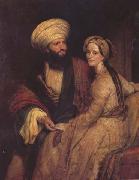 |
Henry William Pickersgill
|
|
English Painter, 1782-1875
was an English painter specialising in portraits. He was a Royal Academician for almost fifty years, and painted many of the most notable figures of his time. Born in London, Pickersgill was adopted in his youth by a Mr Hall, a silk manufacturer in Spitalfields, who financed his schooling and then took him into the family business. However, when war caused difficult trading conditions, Pickersgill opted to develop his talent for painting into a career, and was a pupil of landscape artist George Arnald between 1802 - 1805 before entering the Royal Academy Schools as a student in November 1805.His early subjects were varied and included landscapes and classical and historical themes, but he eventually settled to portraiture as his speciality. His first exhibit at the Royal Academy was a portrait of his benefactor Mr Hall, and during his lifetime he showed a total of 384 paintings there. He was elected to associate membership of the Academy in November 1822 and full membership in February 1826. Pickersgill was one of the pre-eminent portrait painters of his day. William Wordsworth, George Stephenson, Jeremy Bentham, Elizabeth Barrett Browning, Lord Nelson, the Duke of Wellington and Faraday were among the many notable people who sat for him. He famously painted author James Silk Buckingham and his wife Elizabeth in Arab costume in 1816, reflecting Buckingham's own travels in the East as well as the fashion of the times for the Orient. The National Portrait Gallery, London has over 50 of his portraits in its collection, including 16 original oils and 35 engravings after him, along with a small number of portraits of Pickersgill himself by others. From 1856?C64 he was librarian of the Royal Academy. He retired from the institution in December 1872, and died at his home in Blandford Square, London at the age of 93. Pickersgill's brother Richard, son Henry Hall and nephew Frederick Richard were also painters. |
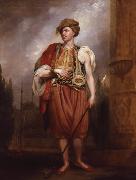 |
Henry William Beechey
|
|
Sir Henry William Beechey (12 December 1753 - 28 January 1839), English portrait-painter, was born at Burford, the son of William Beechey (*1732) and Hannah Read (*c1732).
He was originally meant for a conveyancer, but a strong love for painting induced him to become a pupil at the Royal Academy in 1772. Some of his smaller portraits gained him considerable reputation; he began to be employed by the nobility, and in 1793 became associate of the Royal Academy. In the same year he was made portrait-painter to Queen Charlotte. His work has been described as relatively sober.
He painted the portraits of the members of the royal family, and of nearly all the most famous or fashionable persons of the time. What is considered his finest production is a review of cavalry, a large composition in the foreground of which he introduced portraits of George III, the Prince of Wales and the Duke of York, surrounded by a brilliant staff on horseback. Among his portraits were those of Lord Nelson, John Kemble, and Sarah Siddons.
George III and the Prince of Wales reviewing troops was painted in 1798, and obtained for the artist the honour of knighthood, and his election as RA (member of the Academy). This painting was destroyed in the 1992 Windsor Castle fire.
|
 |
Henry Warren
|
|
Henry White Warren (1831-1912) was an American Methodist Episcopal bishop and author, brother of William Fairfield Warren. He was born at Williamsburg, Mass., and graduated in 1853 at Wesleyan University, Middletown, Conn. He taught ancient languages at Wesleyan Academy, Wilbraham, Mass. (1853-55), and then entered the New England Conference (1855). On April 6, 1855, he married Miss Diantha Kilgore, in Lowell, Massachusetts. In 1863 he was a member of the Massachusetts Legislature.
His wife died June 21, 1867, after having borne three children: Carrie, Henry and Ellen. After serving churches about Boston he was transferred to the Philadelphia Conference (1871) and was elected Bishop (1880).
When he visited Colorado for the first time in 1879 he met the widow of John Wesley Iliff, Mrs. Elizabeth Iliff. They were married on December 27, 1883. |
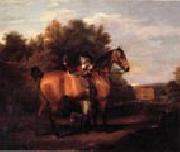 |
Henry Walton
|
|
British Painter ,
c 1746-1813
He studied in London under Johan Zoffany c. 1769, after which he completed his training at the Maiden Lane Academy. It was probably Zoffany who introduced Walton to the conversation piece, a genre in which he was to specialize. The Cricket Scene at Harrow School (1771; priv. col., see 1963 exh. cat., no. 1) reveals Walton's debt to Zoffany, but it also shows him to be an exceptional colourist and able to compose his figures with a sense of rare warmth and intimacy. By c. 1778, when he painted the Rev. Charles Tyrrell with his Family |
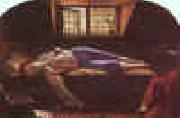 |
Henry Wallis
|
|
British
1830-1916
1916). English painter, writer and collector. He first studied at F. S. Cary academy and in 1848 entered the Royal Academy Schools, London. He is also thought to have trained in Paris at some time in the late 1840s or early 1850s, first in Charles Gleyre atelier and subsequently at the Ecole des Beaux-Arts. He specialized in portraits of literary figures and scenes from the lives of past writers, as in Dr Johnson at Cave, the Publisher (1854; untraced). His first great success was the Death of Chatterton (London, Tate), which he exhibited at the Royal Academy in 1856. The impoverished late 18th-century poet Thomas Chatterton, who while still in his teens had poisoned himself in despair, was a romantic hero for many young and struggling artists in Wallis day. He depicted the poet dead in his London garret, the floor strewn with torn fragments of manuscript and, tellingly, an empty phial near his hand. The painting was universally praised, not least by John Ruskin who described it as faultless and wonderful, advising visitors to examine it well, inch by inch. Although Wallis was only loosely connected with the Pre-Raphaelite movement, his method and style in Chatterton reveal the importance of that connection: the vibrant colours and careful build-up of symbolic detail are typical Pre-Raphaelite concerns. The success of Chatterton was such that, when exhibited in Manchester the following year, it was protected from the jostling crowds by a policeman. It was bought by another artist, Augustus |
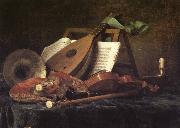 |
henry wadsworth longfellow
|
|
1807-C82, American poet, b. Portland, Maine, grad. Bowdoin College, 1825. He wrote some of the most popular poems in American literature, in which he created a new body of romantic American legends. Descended from an established New England family, after college he spent the next three years in Europe, preparing himself for a professorship of modern languages at Bowdoin, where he taught from 1829 to 1835. After the death of his young wife in 1835, Longfellow traveled again to Europe, where he met Frances Appleton, who was to become his second wife after a long courtship. She was the model for the heroine of his prose romance, Hyperion (1839). From 1836 to 1854, Longfellow was professor of modern languages at Harvard, and during these years he became one of an intellectual triumvirate that included Oliver Wendell Holmes and James Russell Lowell. Although a sympathetic and ethical person, Longfellow was uninvolved in the compelling religious and social issues of his time; he did, however, display interest in the abolitionist cause. |
 |
Henry Otto Wix
|
|
Henry Otto Wix (1866 - 1922), also known as Otto Wix, was a German-born landscape and portrait painter who emigrated to the United States in the late 1890s. He studied in New York, but visited Hawaii in 1907 and 1908-9. About 1910, he moved to San Francisco, but visited Hawaii again in 1912. He also made several sketching trips to Mexico. Wixes marriage ended in divorce, resulting in depression and alcoholism. He died by his own hand in Santa Barbara, California on March 13, 1922.
Wix is best known for his landscapes in watercolor. The Honolulu Academy of Arts and the Smithsonian American Art Museum are among the public collections holding paintings by Henry Otto Wix |
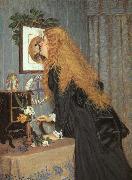 |
Hennessy, William John
|
|
English, 19th Century.was an Irish artist. William John Hennessy was born in Thomastown, County Kilkenny in 1839. His father, John Hennessy, was forced to leave Ireland in 1848 as a result of his involvement in the Young Ireland movement. He landed in Canada and settled in New York. William, his mother Catherine, and brother joined their father there in 1849. He gained admittance to the National Academy of Design in 1854 and exhibitioned his first works there. Hennessy developed a skill in wood engraving and was hired to illustrate the works of renowned poets, including that of Tennyson, Longfellow and Whittier. As an American he became the co-founder of the Artists?? Fund Society, and an honorary member of the American Society of Painters in Watercolours. In 1870 he moved to London where he became a member of the Royal Institute of Oil Painters in 1902. |
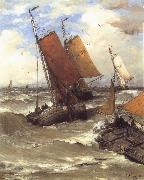 |
Hendrik Willem Mesdag
|
|
Hendrik Willem Mesdag was born on February 23, 1831 in Groningen. His father, a merchant and banker, was an amateur painter who saw to it that his two sons were also educated in the art of painting. He was a Dutch marine painter. He was born in Groningen, the son of the banker Klaas Mesdag and his wife Johanna Wilhelmina van Giffen. Mesdag was encouraged by his father, an amateur painter, to study art. He married Sina van Houten in 1856, and when they inherited a fortune from her father, Mesdag retired from banking to pursue a career as a painter. He studied in Brussels with Willem Roelofs and in 1868 moved to The Hague to paint the sea. In 1870 he exhibited at the Paris Salon and won the gold medal for The Breakers of the North Sea. Preparations for departureIn 1880 he received a commission from a Belgian company to paint a panorama giving a view over the village of Scheveningen on the North Sea coast near The Hague . |
|
|
Helen Allingham,R,W.S
|
|
1848-1926
Studies of Flowers
Studies of Flowers .was a well-known watercolour painter and illustrator of the Victorian era. Helen Mary Elizabeth Paterson was born in Swadlincote in Derbyshire,[1] England. Her sister and her father, a doctor, died of diphtheria in 1862, and the rest of the family went to live in Birmingham. In 1867 she went to study art at the "Female School of Art", a section of what became the Royal College of Art in London, and became an illustrator of children's books. She was a great friend of Kate Greenaway. On 22 August 1874, she married William Allingham, who was almost twice her age. At the time, she was employed in illustrating some of the novels of Thomas Hardy, and they were attracted to one another when they met. Helen Allingham illustrated several books, including Six to sixteen: a story for girls (1876), Happy England (1903) and The homes of Tennyson (1905), written with her brother Arthur Paterson. After her marriage to Allingham, she became a watercolour painter, and she was the first woman to become a full member of the Royal Watercolour Society. As well as landscapes, she completed several portraits, including one of Thomas Carlyle. |
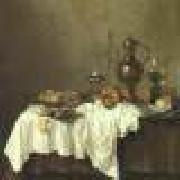 |
HEDA, Willem Claesz.
|
|
Dutch painter (b. 1594, Haarlem, d. 1680, Haarlem).
Dutch still-life painter. His excellent studies of tables laden with food, called ontbijt still life, are seen in many important European galleries. They are characterized by delicate lighting effects and somber colors. |
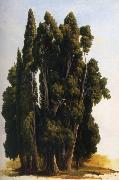 |
Gustaf Wilhelm Palm
|
|
Swedish, 1810-1890,Swedish painter. He entered the Royal Academy of Arts in Stockholm in 1828, where he was a student of Carl Johan Fahlcrantz. Following a tour of Norway he went, via Copenhagen, to Berlin and Vienna for three years in order to seek a cure for an eye illness. He was influenced there by Biedermeier painting and Ferdinand Georg Waldm?ller, and also by the architectural painters Jakob Alt (1789-1872) and his son Rudolf Alt. |
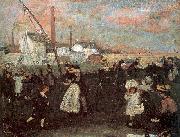 |
Glackens, William James
|
|
American Ashcan School Painter, 1870-1938
American painter and illustrator. He graduated in 1889 from Central High School, Philadelphia, where he had known Albert C. Barnes, who later became a noted collector of modern art. He became a reporter-illustrator for the Philadelphia Record in 1891 and later for the Philadelphia Press. In 1892 he began to attend evening classes in drawing at the Pennsylvania Academy of Fine Arts, studying under Thomas Anshutz. In the same year he became a friend and follower of Robert Henri, who persuaded him to take up oil painting in 1894. Henri's other students, some of whom were referred to as the Ashcan school, included George Luks |
 |
George Willison
|
|
Portrait painter who was born in Edinburgh in 1741 and returned there to spend his retirement.
He was a pupil of Mengs in Rome, before Mengs left for Madrid in 1761.
He painted "Boswell" in Rome in 1765 which is now in the Scottish National Portrait Gallery.
Willison was in London from 1767 and exhibited at the Scottish Academy between 1767 - 1770, and at the Royal Academy in 1771 and 1772.
He left London for an opulent retirement in Edinburgh around 1784.
|
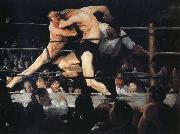 |
George Wesley Bellows
|
|
American Ashcan School Painter, 1882-1925
American painter and lithographer. He was the son of George Bellows, an architect and building contractor. He displayed a talent for drawing and for athletics at an early age. In 1901 he entered Ohio State University, where he contributed drawings to the school yearbook and played on both the basketball and baseball teams. In spring of his third year he withdrew from university to play semi-professional baseball until the end of summer 1904 |
 |
George Webster
|
|
Please search for George Webster (painter) in Wikipedia to check for alternative titles or spellings. |
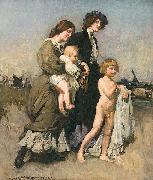 |
George Washington Lambert
|
|
(13 September 1873 - 29 May 1930) was an Australian artist, known principally for portrait paintings and as a war artist during the First World War.
Lambert was born in St Petersburg, Russia, the posthumous son of George Washington Lambert (1833 - 25 July 1873, in London) of Baltimore, Maryland. The younger Lambert's mother was Annie Matilda, nee Firth, an Englishwoman. Mother and son soon moved to Werttemberg, Germany, to be with Lambert's maternal grandfather. Lambert was educated at Kingston College, Yeovil, Somerset. The family, consisting of Lambert, his mother and three sisters, decided to emigrate to Australia. They arrived in Sydney aboard the Bengal on 20 January 1887. |
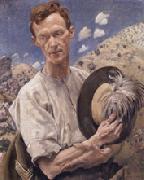 |
George W.Lambert
|
|
Russia-born Australian portrait painter
1873 - 1930
Australian painter, draughtsman and sculptor. He lived for a period in Europe and emigrated to Australia in 1887. He trained under Julian Rossi Ashton, gaining early recognition for his draughtsmanship. In 1901 he studied in Paris at the Acad?mie Colarossi under Auguste Del?cluse (b 1855). He was strongly influenced by the work of Diego Vel?zquez and Edouard Manet. The work of Sandro Botticelli later inspired him to paint in a high key and with an enhanced realism, as in Important People (1914; Sydney, A.G. NSW). He lived in England from 1902 to 1921 |
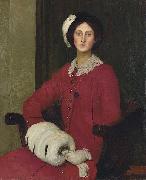 |
George Spencer Watson
|
|
R.O.I., R.P., A.R.A., R.A. (8 March 1869, London - 11 April 1934, London) was an English portrait artist of the late romantic school who sometimes worked in the style of the Italian Renaissance. He studied at the RA Schools from 1889, exhibited at the Royal Academy from 1891. He won Royal Academy Schools Silver Medals in 1889 and 1891, and the Landseer Scholarship in 1892. He was elected R.O.I. in 1900, R.P. in 1904, A.R.A. in 1923, and a Member of the Royal Academy (R.A.) in 1932.
He married Hilda, a dancer and mime artist, and follower of the actor Edward Gordon Craig. They had a daughter, Mary Spencer Watson (1913 - 2006), who became a sculptor. In 1923 he bought Dunshay Manor in the hills of the Isle of Purbeck, after already have spent holidays in Swanage.
He died in London and a memorial exhibition was held at the Fine Art Society in the same year. There is a memorial to him in the north vestibule of St James's Church, Piccadilly, London.
Some of his works are held at Tate Britain, the Harris Art Gallery, Preston and collections in Bournemouth, Liverpool, Plymouth and the National Gallery of Canada. Born in London, Watson studied at the Royal Academy from 1889; he exhibited there from 1891 and also at the Paris salon. Retrospective exhibitions were held at the Galerie Heinemann, Munich in 1912, and at the Fine Art Society in 1914. His work A Lady in Black (1922) is owned by the Tate Collection.
|
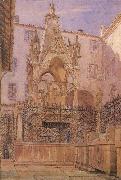 |
George Price Boyce,RWS
|
|
1826-1897
English painter. He was the son of a prosperous wine merchant and pawnbroker. His childhood was spent in London, and in 1846 he was apprenticed to the firm of architects Wyatt & Brandon, where he remained for three years. He was always fascinated by ancient buildings but gradually lost interest in architecture as a career. In 1849, perhaps as a result of meeting David Cox at Betws-y-Coed (Gwynedd, Wales), he decided to become a painter. In the early 1850s Boyce drew landscape and architectural subjects with a fluent watercolour technique derived from Cox. In 1854 Boyce made an extended journey to Italy; he painted views of buildings in Venice and Verona |
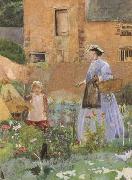 |
George John Pinwell,RWS
|
|
1842-1875
English illustrator and painter. He was born in humble circumstances and was largely untrained. He was briefly a student at St Martin's Lane Art School and at Heatherley's. From 1863 he contributed woodblock illustrations to magazines, establishing his reputation in 1865 with the Dalziel brothers' editions of The Arabian Nights and The Works of Oliver Goldsmith. Pinwell's finest drawings were commissioned for the Dalziels' poetry gift-books. With another illustrator, John William North (1842-1924), he worked at Halsway Manor in Somerset in 1865, experimenting with formal effects based on the structure of stone farm buildings or on the wooden beams of barn interiors (his drawings do not seem to have survived). Some of the illustrations for A Round of Days (1866) and Wayside Posies (1867) present an ideal vision of the countryside, but a vein of social concern is also present. In The Journey's End, from Wayside Posies, a strolling player lies dead, worn out by hardship and hunger. For an illustrated edition of Jean Ingelow's Poems (1867), |
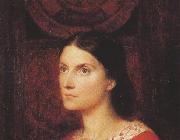 |
George Frederick watts,O.M.,R.A.
|
|
1817-1904
English painter and sculptor. He studied at the Royal Academy and in Italy, where he developed an enthusiasm for Renaissance painting and Greek sculpture that greatly influenced his work. He executed several decorative commissions, including his large fresco Justice (Lincoln's Inn, London), modeled after Raphael's School of Athens. Many of his allegorical pictures are in the Tate Gallery, London. The National Portrait Gallery, London, contains a large collection of his portraits of eminent contemporaries. The Metropolitan Museum has his Ariadne in Naxos. |
 |
Georg Weissmann
|
|
painted Christian Ludwig II, Duke of Mecklenburg-Schwerin in 1731 |
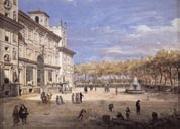 |
Gaspar Van Wittel
|
|
Dutch Baroque Era Painter, ca.1653-1736
was a Dutch landscape painter. Van Wittel learned painting in his hometown of Amersfoort. His first extant works were made in Hoorn in 1672, but he relocated to Rome with his family ca. 1675 and made his career there. In Amersfoort, he likely was exposed to Dutch landscape artists such as Jan van der Heyden and Gerrit Berckheyde. He married in Rome in 1697, and stayed most of his life in that city, though, between 1694 and 1710, he toured Italy and painted in places like Florence, Bologna, Ferrara, Venice, Milan, Piacenza and Naples. He is one of the principal painters of topographical views known as vedute. His son Luigi would become a famous architect and also carries the italianized family name of Vanvitelli. In Luigi's biography is written that his father was born in July 1656, |
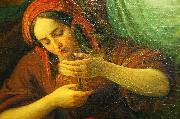 |
Friedrich Wilhelm Schadow
|
|
Friedrich Wilhelm Schadow (7 September 1789 - 19 March 1862) was a German Romantic painter.
He was born in Berlin and was the second son of the sculptor Johann Gottfried Schadow.
In 1806-1807 Friedrich served as a soldier. In 1810 he traveled with his elder brother Rudolph to Rome where he became one of the leaders among painters of the Nazarene movement. Following the example of Johann Friedrich Overbeck and others, he joined the Roman Catholic Church, and held that an artist must believe and live out the truths he essays to paint. The sequel showed that Schadow was qualified to shine more as a teacher and mentor than as a painter. As an author, he is best known for his lecture, Ueber den Einfluss des Christentums auf die bildende Kunst (About The Influence of Christianity On The Visual Arts) (Desseldorf, 1843), and the biographical sketches, Der moderne Vasari (Berlin, 1854).
In Rome, Schadow was given one of his first major commissions when the Prussian Consul-General, General Jakob Salomon Bartholdy, befriended the young painter, and asked him and three young compatriots (Cornelius, Overbeck and Veit) to decorate in fresco a room in his house on the Pincian Hill. The overall theme selected was the story of Joseph and his brethren, and two scenes, the Bloody Coat and Joseph in Prison, were conferred on Schadow. In 1819, Schadow was appointed professor in the prestigious Berlin Academy of the Arts, and his ability and thorough training gained many devoted disciples.
It was during this period that Schadow developed his paintings for churches. In 1826, Professor Schadow was made director of the Desseldorf Academy of the Arts, which he reoriented towards the production of Christian art, though he began a major dispute with one of its professors, Heinrich Christoph Kolbe, ending in the latter leaving the Academy in 1832. In 1837, Schadow selected, at request, those of his students best qualified to decorate the chapel of St Apollinaris on the Rhine with frescoes. When finished, they were acclaimed as the fullest and purest manifestation of the spiritual side of the Desseldorf school. One of his famous students, Heinrich Mucke, carried on the liturgical art with emphasis both in painting and frescoes. The painting of the "Wise and Foolish Virgins," considered one of his masterworks, was commissioned in 1842. Now in the Städel Museum, this large and important picture, while carefully considered and rendered, it however lacks power of some of his other works. |
 |
fredrik westin
|
|
Fredric Westin, född den 22 september 1782 i Stockholm, död 13 maj 1862 i Stockholm, historie- och porträttmålare.
Westin hade varit elev hos Lorens Pasch d.y. och Louis Masreliez på Konstakademien. Sedan han 1808 blivit kallad till akademiens agr?? och förordnad till konduktör vid kungliga museet blev han 1812 invald i Konstakademiens styrelse. Han blev 1815 vice professor och 1816 professor vid Konstakademien. Där var han också 1828-1840 direktör. 1843 utnämndes han till hovintendent.
Till hans tidigare skede och till hans främsta alster hör "Dagens stunder", fyra dörrstycken i Karl Johans sängkammare på Rosersbergs slott med antikiserande figurer: Aurora som strör blommor över jorden, Apollon med sitt fyrspann, Diana följd av Aftonrodnaden samt Natten med sitt stjärnströdda dok (1812-13). På Säfstaholms slott finns "De fyra årstiderna presiderade av jordens gudinna" (1843), på Rosendals slott "Hebe med örnen" (1832) och "Flora bekransande Linn??s byst" (1843) och vid Stockholms universitet "Musiken, föreställd av en grupp unga flickor". Han målade också kompositioner ur den svenska historien ("Olof Skötkonungs dop", "Lutherska lärans antagande").
Westin målade en stor mängd porträtt då han under Karl XIV Johans tid var konstnären på modet. Som porträttmålare var han dock inte enhälligt uppskattad. En kritiker som Silverstolpe beklagade 1809 att en konstnär som "äger så mycken färdighet till stöd för sitt sökande av idealet" sysselsatte sig med en konst av så lågt värde och hoppades att han "måtte återvända från den platta verkliga världen till den poetiska." Hammarsköld menade 1818 att av de svenska konstnärerna var det Westin som hade de ringaste anlagen för porträttmålning. Scholander kallade hans porträtt för "vaxgubbar". Andra hade lovord att fälla över Westins porträtt. Gerss ansåg att Westins porträtt hade likhet och behag i uttrycket, enkelhet i ställning och klädsel, urval av natur i formerna och säkerhet och sanning i utförandet. Wennberg kallade honom "den förste svenske tecknarens Lorenz Paschs så värdige fosterson".
Under Karl XIV Johans tid målade han rad porträtt på kungafamiljen. 1824 målade han en populär allegori över kronprinsessan Josefinas ankomst till Sverige, där Saga i gul och blå dräkt sitter på marken framför en runsten och blickar upp mot skyn där kronprinsessan i röd och vit dräkt svävar ned på en molntapp omgiven av tre amoriner. 1838 målade han Karl XIV Johan till häst på Ladugårdsgärdet hälsande med den trekantiga hatten.
Efter att Sandbergs altartavla för Sankt Jacobs kyrka hade underkänts vände sig de ansvariga till Westin med uppdraget att måla en altartavla. Målningen, "Kristi förklaring" var klar 1828 och resultatet blev både hyllat och kritiserat. Andra altartavlor av Westin finns i Kungsholms kyrka ("Kristi uppståndelse", 1825), Åbo domkyrka ("Kristi förklaring", 1836), Uddevalla kyrka ("Kristus välsignar barnen") samt Carl Gustafs kyrka ("Kristi begravning", 1832). |
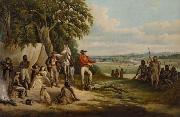 |
Frederick William Woodhouse
|
|
Frederick William Woodhouse
1820-1909
Woodhouse was born in Britain, but is better known as an Australian artist after his move to Australia. He painted images of Bush Life, and made many images from direct observation in sketchbooks and watercolors. He was also Australiaes most important horse racing painter, having painted every Melbourne Cup winner from 1861 until the introduction of the trackside camera. Although horses were his mainstay, Woodhouse also painted dogs, sheep, cattle, landscapes and portraits of persons. Between 1893 and 1894 he made a number of landscapes during a trip to Tasmania. |
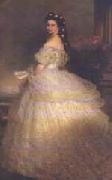 |
Franz Xaver Winterhalter
|
|
German 1805-1873
Franz Xaver Winterhalter Galleries
German painter and lithographer. He trained as a draughtsman and lithographer in the workshop of Karl Ludwig Scheler (1785-1852) in Freiburg im Breisgau and went to Munich in 1823, sponsored by the industrialist Baron Eichtal. In 1825 he began a course of study at the Akademie and was granted a stipend by Ludwig I, Grand Duke of Baden. The theoretical approach to art of the Akademie under the direction of Peter Cornelius was unfamiliar to him, as in Freiburg he had been required to paint in a popular style. He found the stimulus for his future development in the studio of Joseph Stieler, a portrait painter who was much in demand and who derived inspiration from French painting. Winterhalter became his collaborator in 1825. From Stieler he learnt to make the heads of figures emerge from shadow and to use light in the modelling of faces. He moved to Karlsruhe in 1830 with his brother Hermann Winterhalter (1808-92), who had also trained with Scheler and had followed him to Munich. |
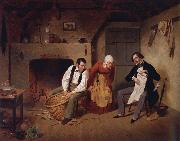 |
Francis William Edmonds
|
|
American, 1806-1863,American painter and banker. He achieved recognition both as a painter and as a banker, juggling careers with consummate skill. In 1826 he enrolled at the National Academy of Design while working in a New York bank. Somewhat insecure, he initially exhibited between 1836 and 1838 under the pseudonym E. F. Williams, but favourable reviews subsequently prompted him to use his own name. In 1840-41 Edmonds spent eight months in Europe, where he studied the Old Masters; he particularly admired the 17th-century Dutch painters Pieter de Hooch and Gabriel Metsu. |
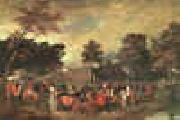 |
Francis Wheatley
|
|
1747-1801
British Francis Wheatley Location
Francis Wheatley (1747 - June 28, 1801), was an English portrait and landscape painter, was born at Wild Court, Covent Garden, London. He studied at Shipleys drawing-school and the Royal Academy, and won several prizes from the Society of Arts. He assisted in the decoration of Vauxhall, and aided Mortimer in painting a ceiling for Lord Melbourne at Brocket Hall (Hertfordshire). In youth his life was irregular and dissipated. He eloped to Ireland with the wife of Gresse, a brother artist, and established himself in Dublin as a portrait-painter, executing, among other works, an interior of the Irish House of Commons. His scene from the Gordon Riots of 1780 was engraved by Heath. He painted several subjects for Boydells Shakespeare Gallery, designed illustrations to Bells edition of the poets, and practised to some small extent as an etcher and mezzotint-engraver. It is, however, as a painter, in both oil and water-color, of landscapes and rustic subjects that Wheatley is best remembered. He was elected an associate of the Royal Academy in 1790, and an academician in the following year. His wife, as Mrs Pope after his death, was known as a painter of flowers and portraits. |
|

